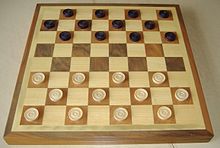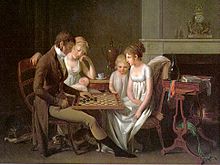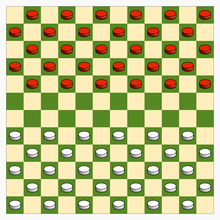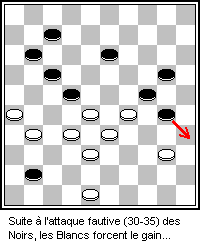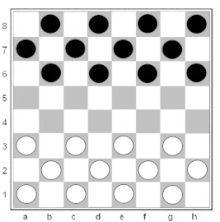Checkers (game)
Checkers is a strategic board game for two players and is played on a chess board with 8 × 8 or internationally 10 × 10 fields. Only the black fields of the board are used, on which the typical disc-shaped game pieces are drawn. The aim of the game is to hit the opposing stones completely by jumping over them or to immobilize them and thus to win the game.
In the German-speaking area, the German checkers are usually played and the game is part of classic game collections , but not very popular as a professional game. In Russia , the Netherlands and other regions, among others , it is played as a professional sport , with different variants being used. There are international championships on the 8 × 8 and 10 × 10 game board, but also national or regional championships of individual variants such as the Turkish checkers , the Russian checkers or the Italian checkers .
The checkers game is one of the games with perfect information and thus enables game strategies whose success does not depend on chance .
history
Checkers are classified as a classic game with ancient roots, but the specific development is not known. The first typical boards and figures come from Egypt from the 16th century BC , but it is unlikely that the game was actually a forerunner of today's checkers.
The modern game of checkers probably originated in the 12th century in what is now Spain or in southern France from the Alquerque (also known as Quirkat) and was played on the chess board available at the time with backgammon pieces . Originally the stones were called heels , after the queen in chess. At that time the queen could only move one square. The innovation was the skipping and taking away of opposing stones from Alquerque. The game was called Fierges at the time . Another similarity with the game of chess used to be that checkers are not obliged to take advantage of every opportunity to hit opponents' pieces. This beating became compulsory around 1535 and was included in the rules as a compulsory beating . If a player missed the opportunity, his piece was "blown" or removed from the board as a punishment. This new form is called "jeu forcé" (the sharp game), the older one "jeu plaisant" (the polite game); today's standard version is the jeu forcé. The renaming of the "ferses" in the chess game to "checkers" led to a parallel renaming of the game to "jeu des dames".

The game spread across France and the rest of Europe. The oldest known printed set of rules, Jeu des Dames , was published in France in 1688.The Polish checkers (now also French checkers) on a board of 10 × 10 fields developed around 1730 and is said to be in Paris by a French official of the royal court and his play partner , a Polish nobleman. In England, the British version of Drafts developed from the checkers game and in 1756, Treatise on the Game of Drafts by William Payne appeared , which, among other things, dealt intensively with the analysis of the endgame variants of the game. English settlers brought the game to the United States , where it became known as Checkers .
In the 1880s, the weekly newspaper Die Gartenlaube often published checkers' games. This suggests that this game was relatively widespread among the population. In 1932 the German Lady Association was founded, which had its seat in Stettin . The monthly newspaper Das Damespiel appeared almost at the same time . However, the association and magazine were banned by the National Socialists as early as 1933 . Currently, the association for the board game Dame eV based in Korbach represents the interests of German checkers players. A checkerboard is also shown in the coat of arms of the city of Trebbin .
Modern checkers 'sport was mainly shaped by the American checkers' player Marion Tinsley , who became world champion in checkers several times after 1955 and was known worldwide as the strongest checkers. In 1992 he competed against the computer program Chinook developed by Jonathan Schaeffer , which lost four games against him and was able to win two of a total of 39 games against him; 33 games ended in a draw ("draw").
Style of play
Game material
Checkers are played on a square board with alternating white and black fields. In many countries, including Germany , Austria and Switzerland , the game board has 8 × 8 fields. So it corresponds to a classic chess board . Internationally, the game is played on a 10 × 10 board (Queen 100), other variants such as the Canadian Queen use a 12 × 12 board. The notation , i.e. the naming of the fields in checkers, is different in the different versions. On the 8 × 8 board, it generally corresponds to chess notation , while in international competitions on the 10 × 10 board, a purely numerical notation is common.
Round and flat pieces serve as pawns, black for one player and white (or red) for the other player. These are usually made of wood or plastic , more rarely of metal or ivory . Each player has 12 stones on the 8 × 8 board and 20 stones on the 10 × 10 board.
Rules of the game
| a | b | c | d | e | f | G | H | ||
| 8th | 8th | ||||||||
| 7th | 7th | ||||||||
| 6th | 6th | ||||||||
| 5 | 5 | ||||||||
| 4th | 4th | ||||||||
| 3 | 3 | ||||||||
| 2 | 2 | ||||||||
| 1 | 1 | ||||||||
| a | b | c | d | e | f | G | H |
To prepare for the game, the game board is placed between the players so that each player sits in front of their own baseline. For the starting line-up, the pieces are distributed on the black fields of the first three rows of the playing field, with Queen 100 the first four rows are occupied.
The game is only played on the dark fields. The stones move one space forward in a diagonal direction. There is generally compulsion to hit, opposing stones must be skipped accordingly and thus hit, provided that the directly adjacent field behind is free. The hitting stone is moved to this free space and if the target space of a jump leads to a space from which another stone can be jumped over, the jump is continued. All skipped stones are removed from the board after the move. You are not allowed to jump over your own pieces.
If a piece reaches the opponent's baseline, it becomes a "queen". This is indicated by placing a second stone on top of it. When the opposing baseline of a piece is reached by capturing opposing pieces, it is also converted to a queen. The train ends with it; it is not possible to immediately capture other opposing pieces by converting to queen. A queen may move forward or backward as much as she likes and jump over and capture individual pieces of her opponent's pieces. When jumping over an opponent's stone, however, the queen must touch down on the diagonal square immediately behind it. If she can jump over other stones from the new space, she must do that too. The rules for jumping for simple stones apply, with the additional rule that the queen can jump forwards and backwards over several fields. Since a queen has to touch down on the field behind the struck stone, it is possible to win an endgame of two queens against a single opposing queen.
The aim of the game is to deprive the opponent of all possible moves, i.e. to capture or block all opposing stones. Players can agree on a tie if they feel that no one can win the game. This is especially the case when both players only have a small number of stones or only one queen left on the field.
Opening and reaction
| a | b | c | d | e | f | G | H | ||
| 8th | 8th | ||||||||
| 7th | 7th | ||||||||
| 6th | 6th | ||||||||
| 5 | 5 | ||||||||
| 4th | 4th | ||||||||
| 3 | 3 | ||||||||
| 2 | 2 | ||||||||
| 1 | 1 | ||||||||
| a | b | c | d | e | f | G | H |
The game is always opened by the white player who moves a piece in his front row diagonally forward one space. The black player reacts accordingly by pulling one of his pieces from the first row. Then the two players try to move each other into a position in which they can hit the opponent's stones without being hit themselves.
Endgame
In the final there are usually only a few pieces left on the playing field from both sides, and both players usually have at least one queen. With tactical moves, both players continue to try to get into a position to block or capture other stones of the opponent. Very often such a game ends in a draw, in which neither side can win.
Tournament rules
In tournament play, the first three moves are usually drawn from a series of predetermined openings (three-move restriction), and both players play this opening once as a white and once as a black player. At these tournaments, checkers are played on 64 fields according to Anglo-Saxon rules. This rule was introduced to reduce the number of tied games that result from certain openings.
In the “international checkers game” there are no comparable rules.
Rule variants
Numerous variants of the checkers game are common internationally. There are widespread game variants and, in some cases, regional differences in individual game rules. The possible variations for the classic lady variants are in detail:
- The board size:
- 8 × 8
- 10 × 10
- 12 × 12
- 14x14
- Moving possibilities of the simple stones:
- one step forward diagonally (same in all variants).
- Possibilities of striking the simple stones:
- Any number of opposing stones, but only forward.
- Any number of opposing stones, forwards or backwards.
- Exactly one opposing stone and only forward.
- Exactly one opposing stone, forwards or backwards.
- Impact compulsion:
- As many opposing stones as possible must be captured.
- If a lady can be hit, that takes precedence over hitting a simple stone.
- If a queen can hit, that takes precedence over hitting with a simple stone.
- (and many more options).
- Train options for women:
- one step diagonally, forwards or backwards.
- Any number of steps, forwards or backwards.
- Hitting opportunities for women:
- Any number of opposing stones.
- The queen must move directly behind the stone that has been struck.
- The queen moves behind any free space behind the individual stone that was hit.
- Exactly one opposing stone.
Blow
The official rules of checkers, which apply in clubs or in tournaments, state that you must always hit if possible ( compulsory hit ). A variant widespread in many countries among non-organized players, on the other hand, allows the opponent to remove the stone that should have hit from the board (so-called "blow" or "blow") instead of insisting that the rule-compliant move is still running.
If you play with "blowing" or "blowing" pieces, there are two basic rule variants:
- In the event that there are several chances to hit at the same time, a move is deemed to have been made correctly as soon as a chances of hitting is perceived. This means that there is no longer any “blowing” or “blowing”.
- The alternative, stricter style of play means that all other possible strokes not perceived on the move lead to the removal of the affected pieces. Of all capture options, only the selected capturing piece remains in play.
There are also many regionally different varieties:
Checkers, draftts
In many English-speaking countries (Great Britain, Ireland, USA, Canada, South Africa, Australia, New Zealand) the queen can only move one space (English Drafts , in the USA Checkers ). With women who are only allowed to move one square, a final of two women against one (with one exception) is always won in favor of the two women.
In April 2007, Jonathan Schaeffer and his group of employees proved that checkers in the aforementioned variant Checkers always ends in a draw with a perfect game. For this purpose, the computer scientists had game positions with 10 pieces or less analyzed together with the 19 most relevant player openings on the board, whereby they had to examine over 39 trillion positions. As a result, it was not necessary to calculate all approx. 5 · 10 20 positions, and yet they were able to find a game strategy in which one can never lose.
International lady
This variant is the most widespread. In Germany it is also called Dame 100 because it is played on a 10 × 10 board. In it, women are allowed to jump and jump as far as they want and simple stones can jump backwards, but not move. In addition, the greatest possible number of opposing stones must be captured on every move in which a capture can be made, whereby no difference is made between queens and simple stones. This variant is played in clubs in over 60 countries, especially in continental Western Europe (France, Benelux), the successor states of the Soviet Union and in many African, but also American and Asian countries that were once French or Dutch colonies. With this queen variant you need at least three, but usually four queens, to win against a single opposing queen.
In French-speaking areas of Canada, especially in the province of Quebec , checkers are played according to the above rules on a 12 × 12 board ("Canadian checkers game"). An anecdote reports that a man got to know the game in Europe. He wanted to teach his compatriots with enthusiasm, but was unsure of the number of fields. He remembered incorrectly and explained the game with the 12 × 12 board. However, this game is also available in the Dominican Republic and Sri Lanka.
Impact lady
In the checkers variant, Schlagdame , the rules are the same as in the checkers game, but the goal of the game is different: As in robber chess , the player who was the first to sacrifice all the stones wins. This variant is also known as Dame-ab .
Bashny
This variant of the Russian checkers offers further interesting complex play possibilities ; Baschni means towers. The game is also known as Stolbowje Schaschki - the turret lady. If a stone hits a stone, it is not removed from the game, but placed under the hitting stone, creating a tower. Stones can hit both forwards and backwards. If a rook is struck, only the top stone of the tower is taken and placed under the hitting stone or tower. If an ordinary stone at the top of a tower reaches the opponent's back row, this stone is promoted to queen. This tower may be moved according to the rules of a queen. If the opposing back row is reached by capturing, a resulting queen or tower queen may have to continue capturing. A clever combination of punching compulsions enables surprising game turns by changing rooks.
Laska
Laska is played on a board with 25 fields in seven rows. The rows have alternating four and three fields. Each party has eleven tokens. The rules correspond to Baschni.
Further regional forms

With the Turkish checkers , which is played in Turkey and neighboring regions, the pieces are not moved diagonally, but vertically forwards or horizontally sideways and captured; both black and white fields are thus used. Women may pull and hit orthogonally in all directions. Hitting is compulsory and with a stroke the greatest possible number must be hit without distinguishing between opposing queens and simple stones. At the beginning of the 8 × 8 board, the second and third rows are each set with eight stones. In this game, two queens win against a single opposing queen. Other oriental queen variants are similar to the Turkish queen.
In the former Soviet Union, Poland and the Netherlands, variants were invented in the 20th century that are played on a game board made up of regular hexagons. The most famous hexagonal queen variant in the west comes from the Dutch game inventor Christian Freeling and is called HexDame .
Computer lady
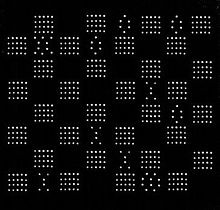
The first checkers program for the Anglo-Saxon checkers game was written by Arthur L. Samuel , a researcher at IBM , in 1952 , and was one of the first ever computer game programs. By 1962, Samuel improved the program several times. A characteristic was the ability of the program to adjust the strategy based on the way the opponents played. This program had no chance against strong human players; nevertheless, it is an important milestone in the development of artificial intelligence .
The strongest checkers program (also Anglo-Saxon checkers) is Chinook , which was written by a group led by Jonathan Schaeffer . Marion Tinsley , the 1955–1962 and 1975–1991 world champion, defeated the program in 1992; due to health problems he had to abandon a game in 1994. Chinook did not compete after winning the human-machine title. The enormous playing strength of today's programs is mainly due to the fact that 10-stone endgames are already available in a huge database. One of the world's most powerful programs is Cake Manchester, a freeware engine for the Checkerboard program . On the site you can find games and other strong engines.
Programs running on PCs today can actually no longer lose to human opponents. However, today there are only a few great masters in checkers, so it is difficult to compare the level of play in the 1980s and 1990s. Also due to the absolute superiority of the computer in checkers, there are only a few young players. Cake Manchester also took part in the 2002 Computer Checkers World Championship in Las Vegas. The winner there Nemesis before Kingsrow and Cake .
In the July 2007 issue of Science , Schaeffer and colleagues showed how they solved the checkers game with Chinook. A perfect game by both players results in a tie.
e-lady
Since 2011, checkers games in the 10 × 10 variant have also been played online on the e-dama.net server. Official championships are held here by the World Correspondence Drafts Association (WCDA). After registering, you can also play friendly games against others here.
literature
- Robert C. Bell: The big book of board games , Domini Sumus Verlag, 1980, ISBN 3-88310-004-8
- Reiner F. Müller: lady, duel with flat stones . Düsseldorf, Econ-Verlag 1988, ISBN 3-612-20367-3
- Jonathan Schaeffer: One Jump Ahead: challenging human supremacy in checkers . New York, Berlin, Heidelberg, among others, Springer 1997, ISBN 0-387-94930-5 - Description of the author of Chinook on the history of his program
Web links
- Dame-online.de Interest group for the board game Dame Germany e. V.
- Homepage of the FMJD, the international lady association (lady 100)
- Homepage of Checkerboard, a free computer version of Dame
- Homepage of Checkersland, a free computer version of Dame
- The international Drafts Committee of the disabled
- Compilation of all lady variations as of September 28, 2018
Individual evidence
- ↑ a b c d e Brian Burns (Ed.): The Encyclopedia of Games. Brown Packaging Books, 1998; P. 150.
- ↑ a b c d e f Frederic V. Grunfeld (Hrsg.), Eugen Oker (German revision): Games of the world I - history, play, do it yourself. Fischer Taschenbuch Verlag, Frankfurt / Main 1985; Pp. 150-152. ISBN 3-596-23074-8 .
- ↑ http://www.dame100-korbach.de/cms/upload/Web2/
- ^ Brian Burns (Ed.): The Encyclopedia of Games. Brown Packaging Books, 1998; P. 151.
- ↑ International Drafts tutorial p.2. Notation on bonaludo.com, accessed on February 4, 2020.
- ↑ 39 Trillion Positions - Invincible Checkers Computer , July 19, 2007 Computer Cannot Lose on Checkers , July 19, 2007
- ↑ Jonathan Schaeffer et al .: Checkers is solved , Science Express, July 19, 2007, doi : 10.1126 / science.1144079
- ↑ How to play Baschni on IGGameCenter, accessed on January 20, 2014
- ↑ How to play Russian Checkers on IGGameCenter, accessed on January 20, 2014
- ↑ e-dama.net
